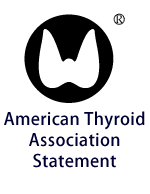
The AMERICAN THYROID ASSOCIATION recognizes that the recent increase in incidence of thyroid cancer in the United States and other countries is, in large part, due to the diagnosis of indolent papillary microcarcinomas that will never result in symptoms or death, and which only rarely will enlarge or spread beyond the thyroid gland. The issues surrounding this problem are twofold: First, medical imaging is identifying small nodules, many that are not clinically significant. Second, these small nodules are subjected to ultrasound-guided FNA, and about 5% reveal cancer cells. The usual next step is surgical removal, often followed by radioactive iodine and life-long thyroid hormone therapy. This approach is costly, creates risks from the treatments, and in most patients offers little or no benefit.
AMERICAN THYROID ASSOCIATION Management Guidelines for Adult Patients with Thyroid Nodules and Differentiated Thyroid Cancer (Thyroid, 2016) address this issue with four important recommendations/suggestions: (1) FNA is not required for thyroid nodules less than 1 cm that appear to be confined to the thyroid; (2) active surveillance can be considered as an alternative to immediate surgery in patients with very low risk tumors, (3) restrict surgery (currently the Standard of Care) to lobectomy and avoid radioactive iodine in those with low risk features; and (4) conduct further research (preferably in the setting of IRB-approved clinical trials) to define the role of active surveillance instead of surgery for patients with low risk tumors (as is currently done for men with indolent prostate cancer), and the role of other tools, such as molecular markers and imaging, in better cancer diagnosis and prognosis.
While additional scientific and medical knowledge is required, the AMERICAN THYROID ASSOCIATION advises that these recommended clinical approaches in the interim may safely and effectively address the recent increased incidence of thyroid cancer.



